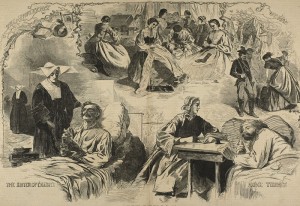
During the Civil War, in the absence of their husbands who were deployed to the battlefront, women entered the public sphere in unprecedented numbers. After the 1861 attack on Fort Sumter, Northern women immediately prepared to support the Union cause by organizing items for the troops, creating sewing circles, and volunteering as nurses[1]. Dr. Elizabeth Blackwell, the nation’s first female physician, and others established The Women’s Central Association of Relief (WCAR) to organize these groups of female volunteers. The WCAR gave way to localized branches of the United States Sanitary Commission[2] (USSC).
Women took on many types of jobs, but were best known for the types of stereotypically domestic jobs performed by the WCAR and shown in Winslow Homer’s “Our Women in the War,” published in the September 6, 1862 edition of Harper’s Weekly. In this engraving, multiple vignettes show women bringing the comfort of the home front to the soldiers of the battlefront while captions underscore the domestic nature of their public participation.
Across the top of the image, arched text at the corners reading “the influence of woman” softens the composition. Underneath this frame, women perform assorted tasks. A nun in the vignette on the bottom left provides a bed-ridden man with a rosary, offering spiritual support and healing. Underneath, the text reads “the sister of charity” reinforcing that she is in fact a woman with the exclusively female job of a nun. In the scene on the lower right, a bonneted woman writes a letter as a helpless-looking man dictates. Homer labels the scene “home tidings” and emphasizes the role of the letter-writer as the soldier’s connection to home and an ambassador of the domestic sphere and the comfort it represents. Without her help, he would not be able to communicate with his family. In two separate vignettes at the top of the composition a woman hangs laundry as a military man intimidatingly watches and a sewing circle makes clothing for soldiers. Previously, women performed these jobs at home, but now they do them in the context of the battlefront. By showing women as nurses, seamstresses, and in other traditionally feminine roles, Homer makes woman’s foray into the public sphere palatable for the viewer.
All of the figures in Homer’s image have slightly obscured and anonymous faces. Not one female figure faces the viewer directly. All have generic features and many are in the shadows, which encourages women to see themselves in these roles and was likely meant to inspire women to join the war effort. On the other hand, this strategic move also trivializes the very real accomplishments of individual women making their contributions seem less important than if Homer had decided to depict notable, individual women, such as Florence Nightingale who contributed to the war effort.
The text that accompanies this image in Harper’s Weekly says, “this war of ours has developed scores of Florence Nightingales, whose names no one knows, but whose reward, in the soldier’s gratitude and Heaven’s approval, is the highest guerdon woman can ever win.” By asserting that the reward of appreciation from soldiers is “the highest guerdon woman can ever win”, Harper’s implies that women live to serve men and the best reward they can receive is male gratitude and God’s approval. Additionally, the text references Florence Nightingale, an individual woman whose accomplishments significantly impacted the Crimean war, yet she is used as generic shorthand referring to a type of woman instead of for her specific and important accomplishments.
On the surface, both the text within the image and the caption relay optimistic messages about women and the war. The top text, especially in conjunction with the images, posits women’s positive influence on the war. When both texts are paired together, however, the subtext is less encouraging, implying that women are only capable of this kind of traditionally feminine work. Homer’s work both honors women’s new working roles and sets restrictions for the types of work women should perform. At a time when women’s roles changed, “Our Women in the War” praises this change, yet simultaneously limits the scope of possibilities for progress.
[1] Robertson, Elizabeth. “The Union’s “Other Army”: The Women of the United States Sanitary Commission.” Gilder Lehrman Institute of American History (n.d.). 4.
[2] Robertson. “The Union’s ‘Other Army’”. 6.